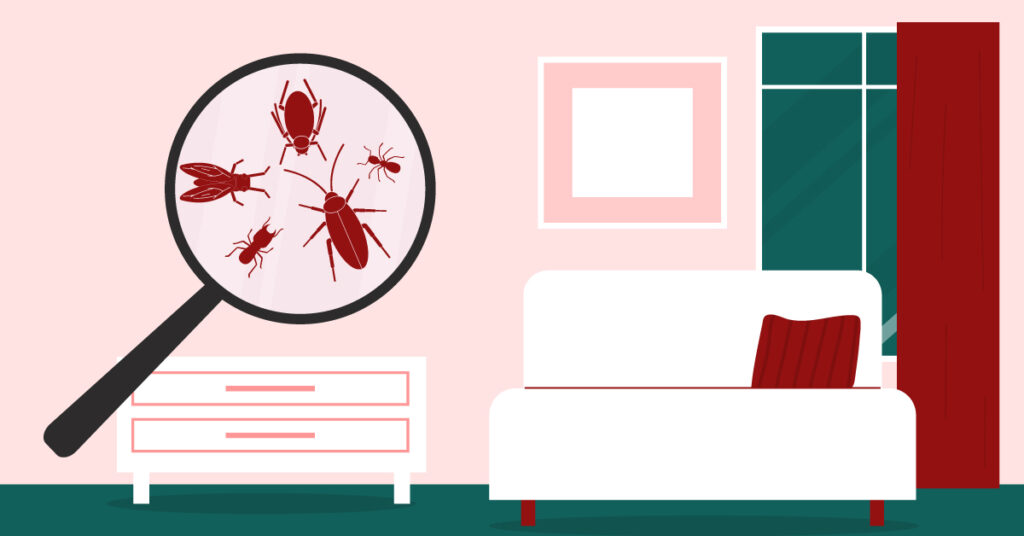Ants are almost impossible to ignore once they invade. These tiny social insects form large colonies, often with one or more queens, and will relentlessly forage for food in your kitchen or build nests under your home’s foundations.
They leave faint pheromone trails that others follow, so spotting one ant usually means there are many more hidden. Common U.S. house ants include carpenter ants (large black ants that tunnel in wood and can damage structures, odorous/sugar ants (small brown ants drawn to sweets, which smell like rotten coconut if crushed), pavement ants (tiny brown ants nesting under concrete slabs), pharaoh ants (tiny yellow ants that live indoors and bud new colonies if disturbed), and, in the South, red imported fire ants (aggressive red ants whose stings are painful and can be dangerous).
Knowing the type of ant you have helps you choose the best treatment. For example, carpenter ants require moisture control and professional treatment, while pharaoh ants respond best to specialized baits.
Stop Ants Before They Come In
Ants often invade homes in search of food or water. Spills, crumbs, pet food and unsealed snacks are like irresistible invitations. To discourage ants, clean regularly by wiping up spills, keeping countertops and floors free of food residue, and storing pantry items in airtight containers.
Empty garbage often and rinse recycling containers. Remove excess moisture (fix leaky pipes, use dehumidifiers in basements, clear gutters). Outside, trim tree and bush branches away from the house, remove wood piles or debris near foundations, and keep mulch or leaf litter away from your walls.
Seal cracks in windows, doors, and the foundation – even a 0.5 mm gap can admit tiny fire ants – using caulk or weather stripping to make entry as difficult as possible. These preventive steps alone can eliminate many ant invaders.
Finding Nests and Trails
If you do see ants marching in a line, don’t just swat them – follow their trail back to a nest if possible. Often, ants form regular paths (along baseboards, edges of counters, or cracks) between an outdoor colony and the food source they’ve found inside.
Placing a dab of sweet jelly or honey near the trail can lure them and reveal the route as they carry it home. Outdoor colonies may appear as small mounds in lawns or under patio stones. Treating the nest at its source (especially for carpenter ants or fire ants) is usually the most effective control method. If a nest is hidden in walls or inaccessible, baiting (below) is often the best option.
Using Baits to Kill the Colony

The most effective way to eliminate ants is to kill the queen(s) and brood inside the nest. That’s what ant baits do. Baits combine a food attractant (such as sugar or protein) with a slow-acting insecticide. Foraging ants consume the bait and carry it back to the colony, where they share it with the queen and larvae. This gradually wipes out the entire nest. Store-bought baits come in stations (e.g., Terro, Combat, Raid) or gels. Place them where ants are active – beside ant trails, near where you see them entering. Masking tape squares or small lids work well to protect gel baits.
Do’s and Don’ts for Baits
Don’t spray insecticide or cleaner near your baits – strong smells deter ants. Instead, leave the bait out continuously (even if it appears that the ants have disappeared) so that new foragers will find it. Initially, you might see more ants at the bait; that’s good – they’re feeding and carrying poison back home.
Be patient: baits can take days or weeks to fully take effect. If one bait seems ignored, try a different ingredient (ants can be finicky, and their preferences may change with the seasons). Always follow label directions: use indoor baits indoors, outdoor baits outdoors. If, after steady use (a week or two), ants still swarm, consider a professional; some invasions (especially by pharaoh or large carpenter colonies) require expert treatment.
Treating Outdoor Nests
For ants nesting outdoors (common with fire ants, pavement ants, and carpenter ants), target the mound directly.
Mound drenches or granules: Pour a liquid insecticide (e.g., products containing bifenthrin, permethrin, or cyfluthrin) into the mound until it’s soaked. Wear long sleeves and gloves to avoid stings (from fire ants) and follow the label instructions for dilution. Granular fire-ant baits are also useful: spread them on or around the mound, and the foraging ants will carry them inside. Repeat if needed – heavy-duty nests or rainy weather may require a second treatment. In lawns, broadcast granular ant bait as a preventive measure in spring and summer; in high-activity areas (especially in the South), reapply every few months to catch new queens before they form big mounds.
If ants are entering from outside but you can’t locate the nest, a perimeter spray can help. Apply a residual insecticide (one with bifenthrin, deltamethrin, or similar) in a 2–4 foot band around your foundation (and up the walls a foot or two). This repels or kills ants that cross the boundary. (Be sure to read labels – some products are outdoor-only.) Avoid spraying freely inside, as indoor sprays only kill the visible workers, not the hidden colony.
Natural (DIY) Remedies
Home remedies can supplement treatment, but are seldom a complete solution for a big ant infestation.
Vinegar or lemon spray: Wiping down countertops and ant trails with a 50/50 mix of white vinegar and water (or lemon juice) masks the scent lines of ants. It may shoo away a few ants, but it won’t eliminate the colony.
Soapy water: A spray of dish soap and water will instantly kill any ants it comes into contact with. Use it to kill swarms of winged “fliers” or large clusters, you see, but expect new workers to appear if the nest is still alive.
Diatomaceous earth (DE): This fine powder (food-grade form) can be sprinkled in wall voids, cracks, or along windowsills. DE cuts through ants’ waxy exoskeletons, dehydrating them over the course of the day. It’s safe for pets and people if applied lightly (avoid inhaling dust). Heavy humidity or water will render it ineffective.
Cinnamon, mint, citrus, coffee grounds, chalk, etc.: Many items (cinnamon sticks, peppermint oil, citrus peels, coffee grounds) are said to repel ants because ants dislike the strong smell. A line of chalk or ground cinnamon can “confuse” or slow an ant trail. Placing mint or basil plants by doors may deter them. These measures might discourage ants temporarily, but ants can often find a way around or simply chew through cardboard barriers, so don’t rely on them.
Homemade baits: Baking soda mixed with sugar attracts ants; the sodium bicarbonate can react and kill some ants internally. Similarly, a mixture of borax (or boric acid) and sugar works well as a DIY bait: the sugar lures ants, and the borax serves as a slow-acting poison. Leave it in a shallow dish near trails.
Caution: Keep borax baits out of reach of children and pets – they are poisonous if ingested.
In general, use natural methods for suppression and prevention (cleaning, repelling, and killing stragglers), but use targeted baits or insecticides to eliminate the nest. Avoid “myth” treatments: pouring boiling water, gasoline, or bleach on mounds rarely kills the queen, and can be dangerous or illegal.
When to Call a Pro
If ants continue reappearing after your best efforts, it may be time to get expert help. Large carpenter ant nests or serious pharaoh ant infestations often require special dust or baits that only a licensed applicator has. Fire ant colonies that threaten play areas or if someone is allergic to stings should be handled by professionals. Pest control companies can identify the species, locate nests (even in walls), and apply strong treatments safely and effectively. They’ll use integrated methods (sealing, baiting, and treating as needed) to tackle tough cases.
Ant control can feel like a battle, but with persistence and the right approach, it’s winnable. Keep your home clean and sealed, follow trails to find nests, and strike with appropriate baits or sprays. Be patient as the bait takes effect, and reapply treatments as directed. By cutting off food and water, targeting the colony at its source, and using both natural deterrents and proven insecticides wisely, most households can beat even the wiliest ant invaders.
You might also be interested in: Rare and Unusual Pests in the Home by Region




